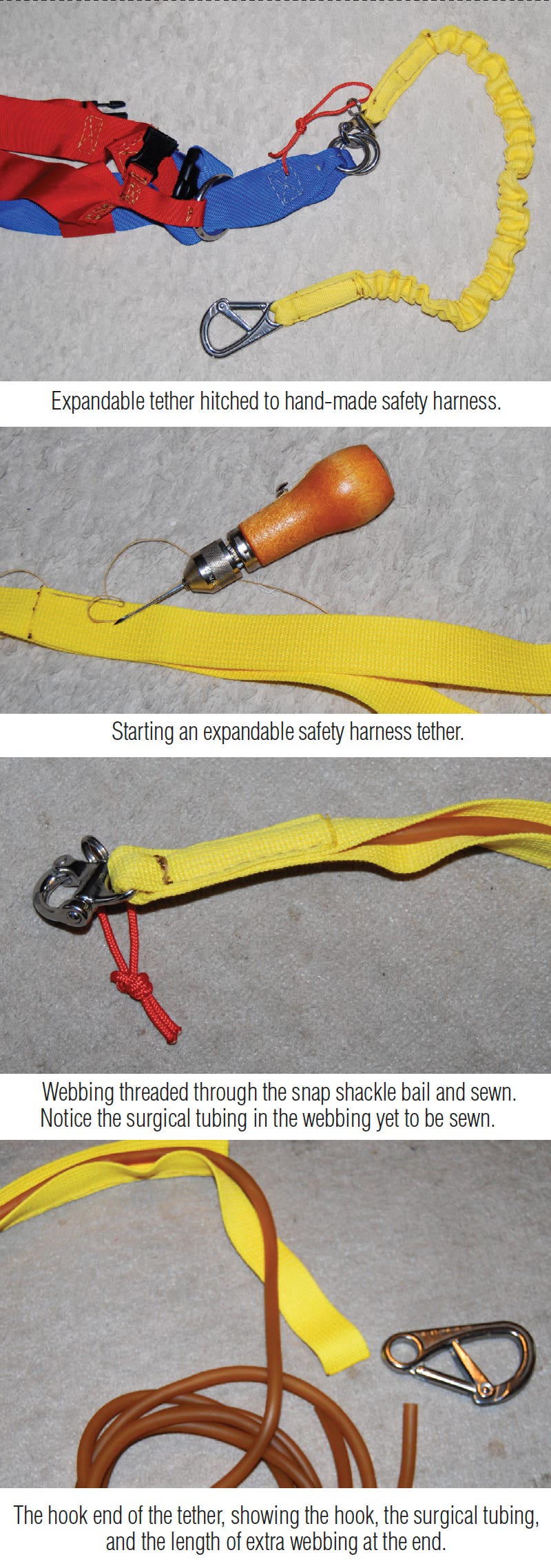By Charles T. Whipple
For years I’ve used 3/8-inch nylon rope for tethers on my safety harness. One is three feet long, and the other six feet, joined in the middle by a snap shackle. I could use either the three-footer or the six-footer, or when necessary use them together for a nine-foot reach.
When I got my classic Bluewater 21 here in Japan, I immediately ordered a safety harness kit from Sailrite, and I rigged it with my usual nylon rope tethers. They continually got in my way on this little boat. After all, its beam is only slightly over six feet, even though it’s 21 feet in length. I longed for an expandable tether. One that would stretch to something like a meter (39 inches).
I checked the online stores. A single short tether could be as little as $49 or as much as $99. And that’s without paying the postage to Japan, which has become a major expense. No one ships surface any more.
So I checked things out.
A stainless snap shackle at the local discount hardware store was $8; the double action safety hook, $15. I looked for tube webbing, but there seems to be no such animal in Japan (around Chiba anyway), so I bought yellow acrylic webbing at $1.50 for a three-meter long by 30 mm wide pack. To make the tether expandable, I got two meters of surgical tubing at $4 per meter (didn’t use all the tubing, I had other things to do with the remainder).
All ready to make my very own expandable tether, because I already had a stitching awl and lots of waxed sail twine.
Step 1
Cut two lengths of webbing, one three feet long and one three feet and six inches. Fold each in the middle and put them together. This positions the inner and outer lengths with leftover bits to put through the shackle and hook.
Step 2
Sew one side of the two lengths together. Keep within 1/8" of the edge. Make the stitches about 3/8" long so the webbing will be able to crinkle up when the surgical tubing contracts.
Step 3
Loop the surgical tubing through the snap shackle and tie it off with sail twine. I suggest you don’t cut the tubing to length yet because you’ll want to stretch it out first.
Step 4
Thread one end of the webbing through the snap shackle bail and fold it back on itself. This will result in the webbing covering the surgical tubing. Insert the tubing between the two lengths of webbing. As you have sewn one side of the two lengths together, this will result in the tubing lying down the center of the lengths so you can sew the other side and trap the tubing inside your tether. At this point, you may want to sew the open side of the two lengths together for a couple of inches. Pull the loose end of the webbing snug and sew it to both sides of the webbing up to the shackle bail.
Step 5
Sew up the other side of the two lengths of webbing, keeping the surgical tubing inside. Remember to make the seam 1/8-inch from the edge and use 3/8-inch stitch lengths.
Step 6
Grab the snap shackle end of the tether and pull the surgical tubing out of the webbing tube you have sewn for it. Play Houdini and roll the tubing about your fist until you can grab the open end of the webbing tube. Let go of the snap shackle (carefully) and the webbing will gradually crinkle up into a shortened tether.
Step 7
Cut the surgical tubing just long enough to loop through the eye of the double-action hook. Thread the tubing through the eye and tie it off with sail twine.
Step 8
Thread the extra length of webbing through the hook eye, double it back over the tubing, and sew it down as you did with the snap shackle.
Behold. An expandable tether for your safety harness.
The same system would work for a six-foot tether, and if you are in the States, you can buy tube webbing from Sailrite and other sources, but you’ll still want to put a line of stitches down each side of the tube. •SCA• First appeared in issue #73
Charles Whipple, a native of Arizona, lives with his wife in Japan. He sails a Blue Water 21 on Tokyo Bay, and writes westerns as Chuck Tyrell and fantasy novels and nonfiction as Charles T. Whipple.




Nice write up for a safety project. I would encourage more thought about the safety element of your tether. Evidence of what happens when the sailor falls over the lifeline/edge of boat on a long tether, using jack-lines running along the port and or starboard sides bow to stern, indicates survival is very low. If safety is the reason for your tether, it should be attached to a jack-line run down the boat’s center line. The tether should be of a size that will not allow the user to fall beyond the edge of the boats deck. Practical Boat Owners magazine posted the results of tether sea trials. The results are eye opening.
Thanks for the great article. Just passed it on to the www.CruisingScots.club